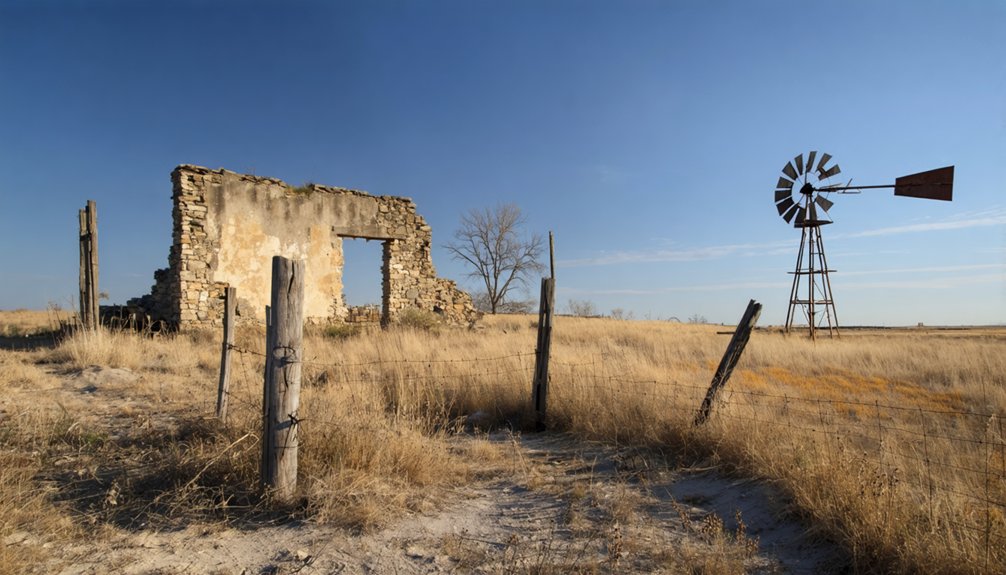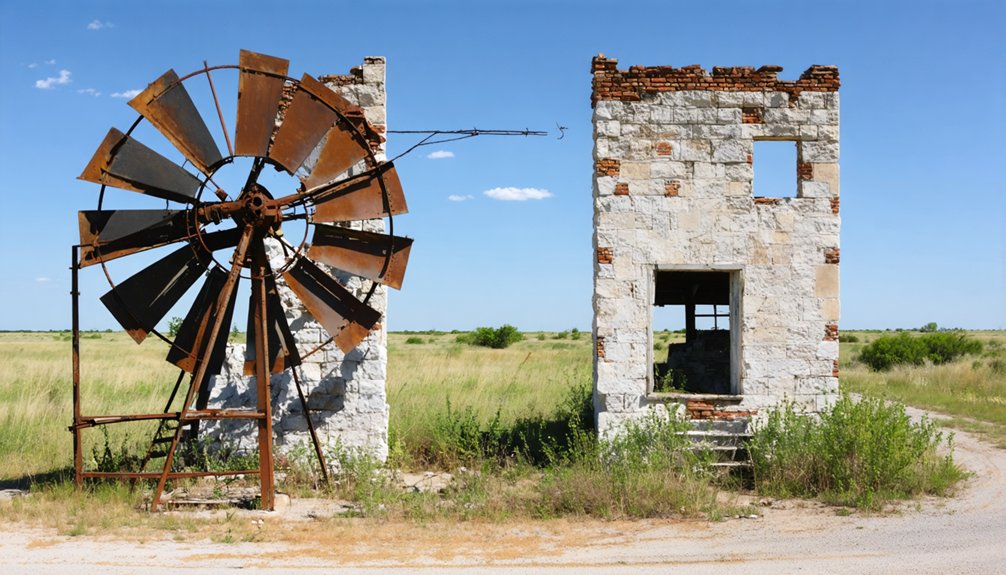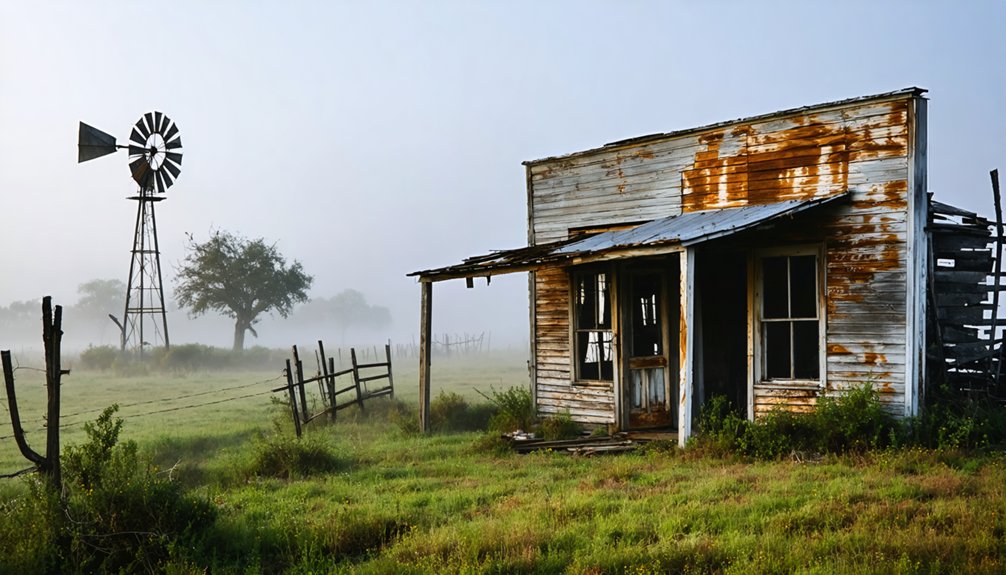You’ll find Wasp Creek located in northwest Kendall County, Texas, about 44 miles southwest of San Antonio. Founded by English immigrant George Lord, this former agricultural settlement once supported 100 residents with cotton farming and livestock operations. The community flourished with general stores, a post office, and cotton gins until railway changes and agricultural mechanization led to its decline. Today, weathered buildings and mining remnants stand among semi-abandoned structures, offering glimpses into Texas frontier life.
Key Takeaways
- Wasp Creek is a semi-abandoned community in northwest Kendall County, Texas, located 44 miles southwest of San Antonio.
- Founded by George Lord, the town flourished as an agricultural hub with cotton farming and livestock before declining.
- Economic challenges, shifting transportation routes, and post-war urbanization led to the town’s eventual abandonment.
- Physical remnants include dilapidated houses, stone foundations, old railroad tracks, and the Wasp Creek Railroad Workers Cemetery.
- Access is limited due to private property restrictions and unpaved roads, with specialized historical maps needed for navigation.
Location and Geographic Features
Nestled in northwest Kendall County, Texas, Wasp Creek lies approximately 44 miles southwest of San Antonio and 19 miles west of Moore.
Hidden away in Texas’ scenic Kendall County, Wasp Creek sits amid rolling hills just 44 miles from bustling San Antonio.
You’ll find this ghost town in the heart of Texas Hill Country, where rolling hills and oak woodlands define the topographical features of the landscape. The area’s ecological significance stems from its position near the Frio River basin, with Wasp Creek serving as an essential tributary that supports local biodiversity. Like many ghost towns in Texas, nature has reclaimed most of the original structures and roads that once existed here.
You can access the site via FM 140 and a network of rural roads that wind through the semi-arid terrain. Similar to nearby Ammans Crossing, the area once supported a population of around 100 residents.
The region’s native grasses and brush vegetation create a classic Hill Country environment, while seasonal creek flows shape the valleys and contribute to the area’s distinct geographic character.
Early Settlement History
The origins of Wasp Creek trace back to George Lord, an English immigrant who arrived in Canada during the 1830s before joining the Republic of Texas Army. After surviving the Mier Expedition and imprisonment in Mexico City, Lord struck gold in California and returned to Texas, where he purchased 8,000 acres of rolling prairie that would become Wasp Creek.
The settlement’s dynamics shifted as pioneer families like the Prestons from Georgia and Thomas Baker from Mississippi arrived, facing typical frontier challenges. The area’s early settlers relied heavily on cotton and livestock farming. Much like the terrain near Písecké hory in Europe, the land featured gentle slopes and woodlands ideal for grazing.
Baker built a log cabin in 1857, marking early permanent structures in the area. By 1880, the community had evolved from scattered homesteads to an organized settlement when shopkeeper Thomas Carter surveyed town lots 90 feet wide, establishing a formal town layout.
Community Life and Development
During its peak years, Wasp Creek flourished as an agricultural community where roughly 150-acre family plots formed the backbone of local life.
Wasp Creek thrived as families tended their 150-acre plots, weaving agriculture into the very fabric of community life.
You’d find prominent families like the Jacksons, Rogers, and Cranfills settling nearby, establishing strong family networks that shaped the town’s social fabric.
The Hicks-Cobb general store, post office, and W.W. Cole Building served as hubs for community gatherings, while local schools and churches brought residents together for education and worship.
When the Chicago, Rock Island and Gulf Railway connected Wasp Creek to larger markets, you could see the town’s commerce thrive. Like many towns along Route 66, the arrival of railroad transportation brought new opportunities for growth and trade.
Daily life centered around farming activities, with residents relying on local businesses for essential services. Like the Texas town of Ayr, Wasp Creek’s prosperity heavily depended on railroad access.
However, as transportation routes began bypassing the town and economic conditions shifted, the once-vibrant community gradually declined.
Economic Rise and Decline
While cotton and cattle initially drove Wasp Creek’s agricultural economy, you’d find the town’s real prosperity emerged after local entrepreneurs began accumulating substantial farmland and attracting commercial ventures.
Settlers like George Lord amassed impressive holdings, with some reaching 8,000 acres, setting the stage for economic prosperity through agricultural expansion. Similar to other towns like ghost towns in Texas, the community’s fate was tied to changing economic conditions.
You’ll see how the arrival of railway connections transformed Wasp Creek into a vibrant commercial hub, complete with general stores and cotton gins.
However, this agricultural dependency proved fatal when multiple challenges hit: shifting transportation routes bypassed the town, agricultural mechanization reduced labor needs, and cotton market fluctuations destabilized the local economy. Much like Thurman, West Virginia, the decline of railway traffic played a crucial role in the town’s downfall.
These factors, combined with broader trends like post-war urbanization, ultimately led to business closures and population decline, pushing Wasp Creek toward its ghost town status.
Notable Structures and Landmarks
Mining operations shaped Wasp Creek’s physical landscape, leaving behind a network of mine shafts and industrial remnants that you can still explore today.
Similar to many abandoned ghost towns, the site stands frozen in time as a testament to its industrial past.
You’ll find grated mine entrances, scattered tailings, and waste rock piles that testify to the area’s rich mining heritage. Old railroad tracks, partially visible near mine entrances, once connected these crucial extraction points. Like the mines of cinnabar in Terlingua, these operations left lasting impacts on the surrounding environment.
The settlement patterns of early residents emerge through stone foundations and chimneys dotting the landscape.
You’ll discover ruins of a once-thriving community, including remnants of administrative buildings, a courthouse, and a jail. While many structures sit on private property, you can still observe the town’s layout through surviving footprints.
Evidence of community infrastructure includes outdoor ovens, dynamite storage facilities, and the foundations of service buildings that supported the mining operations.
Transportation and Accessibility
As transportation networks evolved across Texas, Wasp Creek remained markedly isolated from major routes and railways. During its peak settlement period, you’d find only dirt roads and small trails serving the community, with most travel done by horseback or wagon.
Today, you’ll need to navigate rural backroads to reach the site’s coordinates (31.532942 N, -97.4255694 W). Road conditions are challenging, especially after rain, and you won’t find maintained pathways or visitor facilities.
Your best bet is an off-road capable vehicle, as the terrain includes creek beds and uneven ground. Parking is limited to informal roadside spots, and private property restrictions may affect your access to certain ruins.
These transportation challenges ultimately contributed to Wasp Creek’s decline, as neighboring towns with rail connections drew away residents and commerce.
Demographics and Population Shifts

Since its earliest days in the early 20th century, Wasp Creek maintained a small but tight-knit population of fewer than 50 residents.
Tucked away in rural Texas, Wasp Creek remained home to a close-knit community of under 50 souls throughout its early years.
The community’s demographic changes mirrored those of similar Texas ghost towns, with families primarily engaged in agriculture and railroad work forming the social backbone. You’d find essential services like a post office, school, and general store serving as community anchors during the town’s peak years.
Population trends shifted dramatically after World War II when economic challenges and infrastructure losses triggered steady outmigration.
As families relocated to larger towns seeking better opportunities, Wasp Creek’s social fabric began unraveling. By the 1970s, the closure of the post office signaled the town’s final decline, with remaining residents absorbed into surrounding communities, leaving behind yet another Texas ghost town.
Legacy and Historical Impact
Though Wasp Creek’s historical footprint remains modest, the town exemplifies the common pattern of rural Texas settlements that emerged and faded during the early 20th century.
You’ll find no grand monuments or historical markers commemorating its existence, yet its story reflects the broader narrative of small Texas communities shaped by agricultural roots and close-knit social bonds.
The town’s legacy lives on primarily through local oral traditions, though these accounts remain largely uncollected and unpublished.
While cultural influences from Anglo-American, Hispanic, and indigenous communities likely shaped daily life in Wasp Creek, no distinctive traditions or practices have been documented.
Unlike more prominent ghost towns that left lasting impacts on Texas history, Wasp Creek’s significance lies in its representation of countless similar settlements that quietly disappeared from the landscape.
Current Status and Remains

Today you’ll find Wasp Creek as a semiabandoned community rather than a true ghost town, with some inhabited structures alongside deteriorating buildings.
While accessible by local roads, the site lacks active amenities or services, reflecting its decline from a once-functioning rural Texas town.
The remaining physical elements include dilapidated houses with intact roofs and basic structures, though most buildings show signs of weathering and minimal maintenance typical of declining rural communities.
Physical Site Today
At Wasp Creek, the physical remains present an ambiguous picture of a partially inhabited settlement rather than a traditional ghost town.
You’ll find a few standing buildings with varying structural integrity, though they’re not officially documented in ghost town registries. The physical condition of these structures suggests ongoing habitation by a sparse population rather than complete abandonment.
The surrounding landscape has largely reverted to rural Texas characteristics, with open fields and scattered homesteads.
You won’t find any marked ruins or tourist infrastructure, and most remaining structures are likely on private property, hidden from casual view by natural vegetation.
While some historical buildings from early settlement days may survive, they’re not actively preserved or maintained, leaving the site’s future preservation uncertain.
Access and Location Issues
Locating Wasp Creek’s ghost town presents significant challenges due to its remote position in Kendall County, approximately three miles north of Boerne.
You’ll find the site lacks maintained public roads, with access primarily through old railroad beds and rural tracks that have succumbed to natural overgrowth.
The Wasp Creek Railroad Workers Cemetery serves as a key navigation aid, situated about 300 feet east of Spanish Pass Road.
While this landmark helps orient visitors, you’ll need specialized historical maps since modern commercial mapping systems don’t accurately mark the ghost town’s features.
Your exploration may be further complicated by private property restrictions and central Texas’s seasonal weather conditions affecting unpaved roads.
The absence of functional infrastructure and limited parking also create access challenges for anyone attempting to visit the site.
Remaining Structural Elements
While traversing to Wasp Creek presents challenges, understanding what physical structures remain offers valuable historical context.
Though not officially classified as a ghost town, Wasp Creek shows signs of structural decay typical of semi-abandoned Texas communities. You’ll find some remaining buildings still standing, maintained by the small population that continues to call this place home.
Common structural elements you might encounter include:
- Standing but unoccupied residential buildings
- Old commercial structures with minimal maintenance
- Historic community buildings like churches or schools
- Some visible foundations where buildings once stood
Without detailed surveys or preservation efforts, the site’s exact remaining structures aren’t well documented.
Natural weathering and economic shifts have likely impacted building conditions, though the presence of residents suggests better preservation than completely abandoned towns.
Frequently Asked Questions
What Is the Origin of the Name “Wasp Creek”?
Picture wasps buzzing along a winding stream – you’re seeing how this creek got its name. While the exact Wasp etymology isn’t documented, early settlers likely named it after observing significant wasp activity.
Were There Any Famous Outlaws or Gunfights in Wasp Creek?
You won’t find any confirmed outlaw legends or gunfight history in historical records. Research shows no documented evidence of famous outlaws operating or notable shootouts occurring in this location.
Did Any Natural Disasters Affect the Town’s Development?
While you might expect flood damage or drought impact in Texas ghost towns, there’s no documented evidence of any natural disasters affecting Wasp Creek’s development during its recorded history.
What Native American Tribes Originally Inhabited the Wasp Creek Area?
You’ll find that the Lipan Apaches and Tonkawas first inhabited the area since the 14th century, while the Comanches and Kiowas arrived later, dominating the region by the 18th century.
Are There Any Local Legends or Folklore Associated With Wasp Creek?
You’ll find stories about Wasp Spirits haunting the creek’s waters, though specific documented legends are scarce. Like other Texas ghost towns, there’s a haunted history of shadowy figures and mysterious sounds.
References
- https://www.ghosttowns.com/states/tx/tx_ghst_twns_sect1345.doc
- https://texashighways.com/travel-news/four-texas-ghost-towns/
- https://www.drippingspringsnews.com/article/2977
- https://www.youtube.com/watch?v=phjUE19A8HM
- https://www.southernthing.com/ruins-in-texas-2640914879.html
- https://en.wikipedia.org/wiki/List_of_ghost_towns_in_Texas
- https://www.tshaonline.org/handbook/entries/wasp-creek-kendall-county
- https://texashistory.unt.edu/explore/collections/TGTN/
- https://www.texasescapes.com/TOWNS/Texas-Ghost-Towns-3-Hill-Country.htm
- https://www.youtube.com/watch?v=Ux4FjzHs5DE



